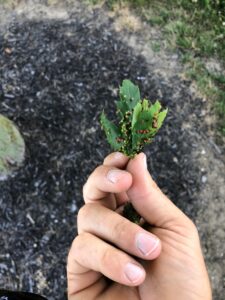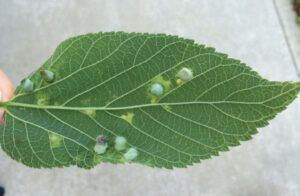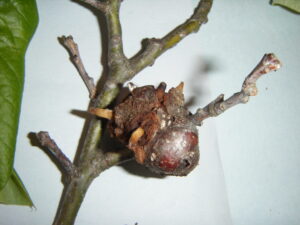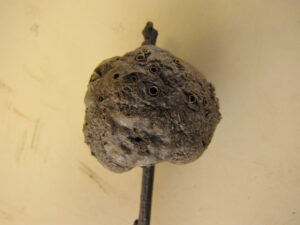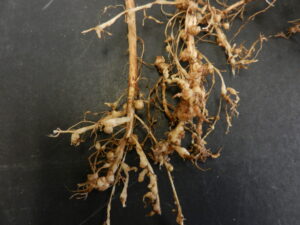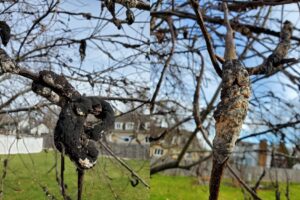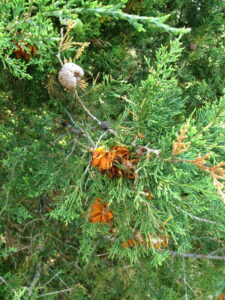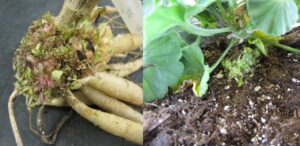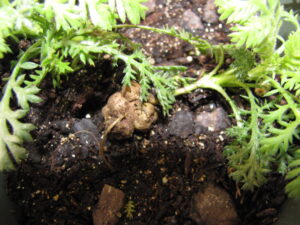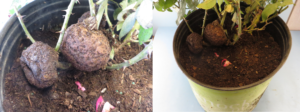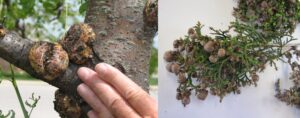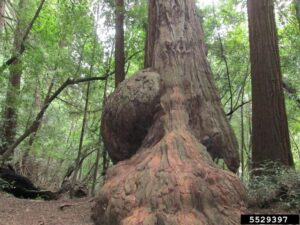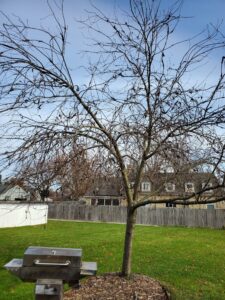
Figure 1. Galls easily visible in the canopy of plum tree in early spring. All Photos from PPDL unless noted.
Galls are gnarly-looking problems for plants and now is the perfect time to be looking for galls on woody ornamentals in the landscape. Without their leaves, these abnormal growths on branches can be easy to spot as you look through the open canopy (Fig 1). There are many different types of galls or gall-like structures caused by various organisms, including arthropods, nematodes, bacteria, fungi, and even plants themselves. A gall is a mass of swollen plant tissue induced by growth stimulating substances produced by the causal organism. Galls may act as a shelter and food, in the case of insects and nematodes; or might be composed of undifferentiated plant tissues leading to a large mass that expands overtime. Depending on the cause, the effect of galls on plants can range from mere nuisance to something that saps energy and causes dieback and decline. Thankfully, the most common galls cause little damage.
Insect and mite gall-makers often produce galls on foliage leading to swollen structures littered across the leaves. These can be colorful, like the bright pink-red maple bladder gall (Fig 2), but often many of the galls are similar in color to the leaf, like the hackberry nipple gall (Fig 3). Leaf galls can cause defoliation if they become highly concentrated, but this does not usually affect plant vigor unless trees or shrubs are repeatedly defoliated in successive years. Some insects, like the wasp that causes horned oak galls (Fig 4), can cause galls to develop on branches. Severe infestations can lead to branch dieback, but this is infrequently the case. Management of arthropod galls can be difficult due in part to their complex life cycles and the fact that they live the majority of their lives within the gall and are protected from insecticides. Removing infested leaves and pruning stem galls can remove the insects, but it can take horned oak galls two to three years to become noticeable. Once holes are observed in the galls, the pests have already flown the coop and management is no longer needed (Fig 5).
- Figure 2. Pink and Green bladder galls developing on maple foliage.
- Figure 3. Hackberry nipple gall developing on the underside of the leaves.
- Figure 4. Horned oak gall with characteristic horns protruding from the swollen branch.
- Figure 5. Old horned oak gall with visible exit holes for mature wasps.
- Figure 6. Root-knot nematode galls in the root system of soybeans. Similar galls can develop in the roots of woody plants as well.
Nematode gall-makers make up a very short list, but include some of the most damaging pests in agricultural production. Root-knot nematodes (Meloidogyne spp.), as the name implies, causes galls in the roots which requires a root sample or uprooting the plant to diagnose (Fig 6). Symptoms you can see above ground include general decline, stunting, chlorosis, and nutrient deficiency symptoms – essentially any type of root damage can look similar to a nematode infestation. Thankfully, root-knot nematodes are not very common in the landscape, but they do have a very wide range of hosts they can attack – over 3000 plant species: Abelia, boxwood, barberry, dogwood, Gardenia, holly, rhododendron, rose, willow, lilac, peach, and Weigela, to name a few. The biggest issue, once present, is knowing what to plant in that spot. Excavating the soil, solarization, and chemical applications are not likely to remove or kill the majority of nematodes and they will persist for many years. Planting tolerant, resistant, or non-host plants in infested spots will reduce the potential for damage in the future. Movement of soil or infested plants will spread the nematode, so if transplanting or dividing perennials, be sure to check the roots out if they don’t appear as healthy as you hope.
Fungal gall-makers can infect both green and woody material. Some fungi, like Phomopsis, might cause large spherical knots to develop on branches, ranging from the size of a pea to larger than a softball, while others, like Apiosporina, causal agent of black knot, can cause galls to form along the length of a branch (Fig 7). Often these structures are irregular in shape and have many cracks across their surface. Rust fungi can cause galls in twigs that produce characteristic rusty-orange spores like cedar-quince rust on hawthorn (Fig 8) or horns like cedar-apple rust on juniper (Fig 9). Gall formation on smaller branches can lead to dieback, but galls on larger branches can lead to plant decline. Galls may not live to the full life of the tree and may die after a few years on a given branch, but the branch may still yet live. Pruning galls out of the canopy can reduce the potential inoculum for future infections and can reduce the drain on the plant.
- Figure 7. Black knot galls on plum; sporulation present is likely a different fungus growing on the gall.
- Figure 8. Right: Active and sporulating gall of cedar-quince rust on hawthorn; Left: old and spent gall.
- Figure 9. Telial galls produced by cedar-apple rust on juniper. Gray and black colored galls are old and spent while the brown galls with orange horns are currently active and producing rust teliospores.
There are two main bacterial gall-makers: Rhodococcus fascians and Agrobacterium spp. Rhodococcus does not typically cause galls in woody plants, but can cause “leafy galls” in herbaceous plants. This type of symptom is a dense concentration of shoots, similar to witches’ broom symptoms in trees, where leaves are packed together on one side of the plant (Fig 10). This can look like a gall, but is comprised mostly by leaves. The other bacterium, Agrobacterium, causes the classic disease crown gall, which can infect over 600 plant species (Fig 11, 12)! Galls can form on roots or the crown and trunk of many plant species, but aerial galls can form on branches of some woody plants, including roses, poplar, willow, and Euonymus. Both of these pathogens do not typically kill the host that they infect, even if growing over the majority of the crown, but it can reduce plant vigor and make them unsaleable. Bacteria enter the plant through natural openings and wounds, so often they are allowed entry by mechanical damage of some sort to the roots (pest feeding injury, frost heaving, damage at planting/propagation) or trunk. If propagating your own plants, be sure to sanitize your tools between plants to avoid spreading a pathogen, especially if you see a gall.
- Figure 10. Symptoms of shoot proliferation or “leafy gall” caused by Rhodococcus fascians.
- Figure 11. Symptoms of crown gall on Anthemis growing in pots.
- Figure 12. Very large galls caused by Agrobacterium tumefaciens on potted rose.
Plants can develop gall-like growth that is not directly associated with a pathogen or pest. Swollen areas can develop on certain plants when subject to growth regulator herbicides, like honeylocust and arborvitae (Fig 13), but trees develop burls commonly both in the landscape and in natural settings (Fig. 14). Burls are an overactive production of callus tissue by the tree to some kind of stress, including physical injury or initial attack by an insect. Burls should not be removed as this will cause significant damage to trees and they are not really causing any harm.
- Figure 13. Injury associated with growth regulator herbicide exposure in honeylocust (left) and arborvitae (right).
- Figure 14. Burls developing on Redwoods in CA. Photo credit: David Stephens, Bugwood.org
There are so many varieties of galls, it can be difficult to keep track of or even identify them. Easiest way to find a gall is to look for a hackberry tree, which always has nipple galls, or by looking for an Oak. Oaks seem to have the longest list of gall-inducing insect pests out there. Having an idea of what kind of gall is present can help you figure out how to manage the causal agent, if it even needs management, and what other plants it might attack in the surrounding landscape.
For additional information on some of the pests listed here, please see the following links:
Insect galls
https://extension.entm.purdue.edu/publications/E-56/E-56.pdf
Rusts of landscape plants
https://www.extension.purdue.edu/extmedia/BP/BP-137-W.pdf
Black Knot
https://www.purduelandscapereport.org/article/black-knot-disease/
